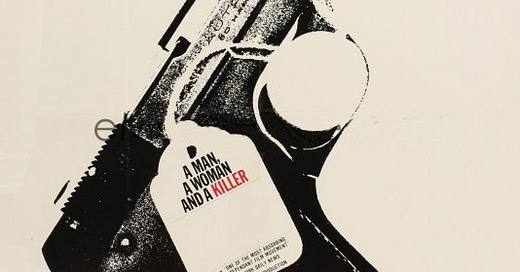PART 3––EDITING "A Man, a Woman, and a Killer,"--the inside story of the POST-PRODUCTION...@PALMER FILMS, San Francisco, CA
Watch movie: https://vimeo.com/936437819
EDITING HELL (1973)
Back in a Palmer Lab editing room, in the familiar confines where I had edited my previous short films, I began to recover from the shoot. I was happy to be syncing up picture and sound tracks from our feature that would eventually be titled A Man, A Woman, and A Killer, propelling myself forward into the (temporary) editorial bliss that any filmmaker can identify with when he or she learns that there is something on the film. There was more than three miles of footage (around 18,000 feet, or 8 hours) from which to hopefully edit the 75-90-minute movie. And the footage looked fantastic!
Between the choice of using soft lights as recommended by George Manupelli, and Wayne’s idea to under-expose 1/2 stop/process as normal, we had some excellent B&W images from our 16MM Plus-X Reversal stock. The blacks of the images were very dense, very punchy against the other whites and grays, like many of the very best foreign films Wayne and I had seen together (Seventh Seal, Persona, La Salamander, Orphee, etc.). I was thrilled to screen the synced-up footage for actors and technicians at the rear projection room at Palmer’s, relieved that I had succeeded at delivering such competent shots when I hadn’t even known how to load the Eclair camera 20 days earlier.
During the shoot, we had mailed one 400’ roll of exposed film to Palmer’s lab for processing and work printing, just to make sure our filmstock wasn’t being scratched while it ran through the camera. A quick phone call to the lab manager two days later had confirmed that the negative was fine, had an image with no scratches. I was told, though, that the exposure looked a bit “on the dark side,” but figured that was OK. Fortunately, it was the good kind of dark – luminous!
Poster designed by Joe DiVincenzo. He would also design and produce posters for SHOWBOAT 1988-THE REMAKE, and MORGAN’S CAKE (Thanks Joe!).
Dick, Wayne, and I had functioned like three runners in a relay race. Dick had been first, writing his thoughts down for the last ten years before we had met. Then he handed Wayne those original writings, along with some new ones, to script into scenes and direct. Wayne had also received writing help from Terrel Seltzer, the clap girl/production assistant on the set, who went on to a successful Hollywood scriptwriting career (she co-scripted the movie, One Fine Day, after helping Wayne with Chan is Missing). Dick then acted as the male lead, while I functioned on-location as production manager, cinematographer, and producer. Then the baton was handed to me, as editor, for the third and final leg of the race. It was my job to cut the results into a finished feature-length film. The responsibility for creating a completed movie was finally in my hands alone and I believed that I was up to the tsk. But I quickly learned that editing a feature-length film was not just three times harder than a 30-minute film (the length of my short film What Flirting Cost Me), but probably 100 times more difficult. I didn’t understand, as yet, how hard it would be to find the structure of an experimental feature, especially the kind of film that has no precise blueprint (script) that dictates the exact order of scenes. I had no idea that instead of weeks, it could take years to complete such a complicated project. And I was already broke.
With the cost of the on-location shoot ($5,900), and additional expenses of processing, work printing, sound transfers from 1/4” audio tape (from Nagra) to mag track for 45 400’ rolls (another $4,000), there was barely $1500 left for me to live on and pay future editing costs. But I felt so emotionally full and happy from seeing the high-quality footage that I seemed impervious to the obvious functional problems of no income and no savings.
––––––––





So many parallels between artistic creation and “spiritual growth.” In each case, in my humble opinion, the Soul is best served by “interfacing with The Mystery,” (to borrow Tom Robbins’ expression.) But, often, that’s at least a two-part process. First you have an “experience,” then you have to learn what it “means.” E.g. People who have so-called Near Death Experiences see and hear and feel amazing things awaiting us in the “Afterlife.” But they return to life on Earth and often take years, even decades, to “integrate” their NDE into “everyday” living. In your story, you are thrilled with the film footage you all made, but now, as Editor, you must discover what it MEANS, what the structure of the Story will be. May take 100 times as long!